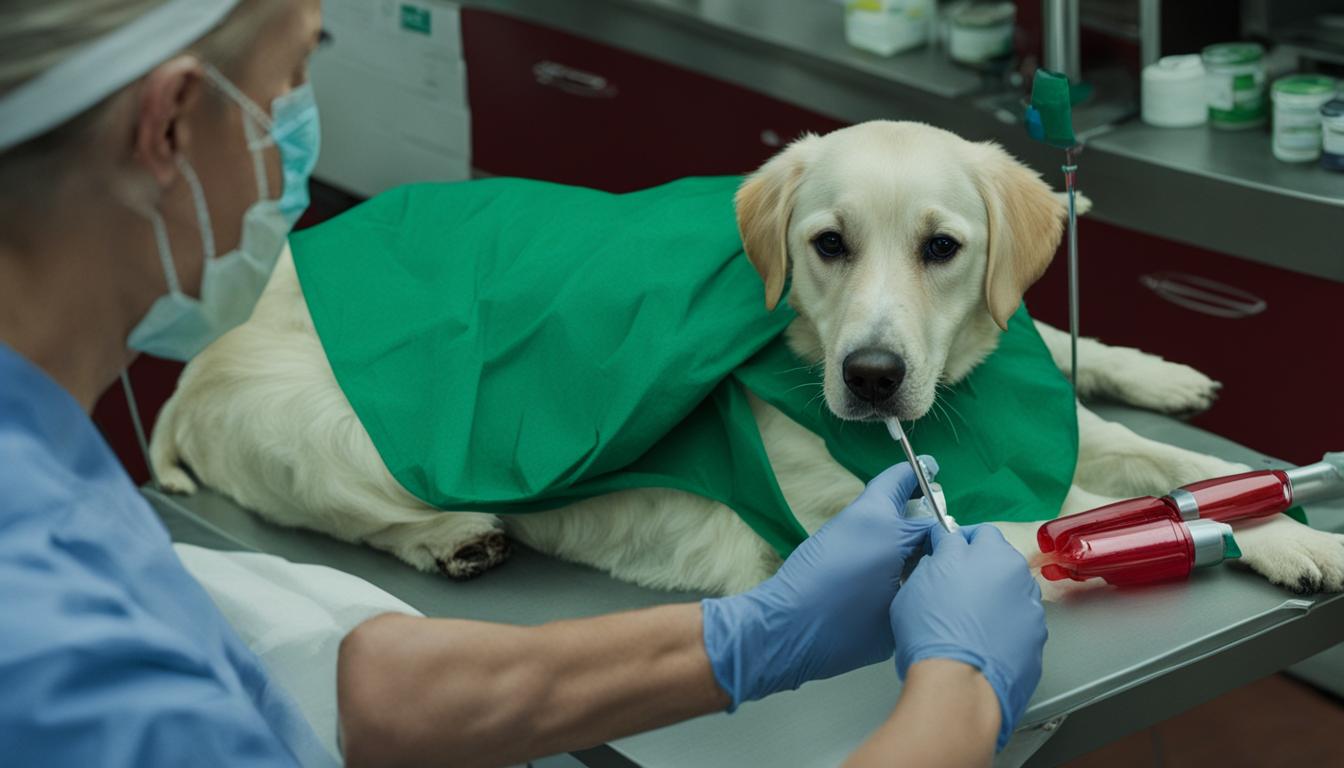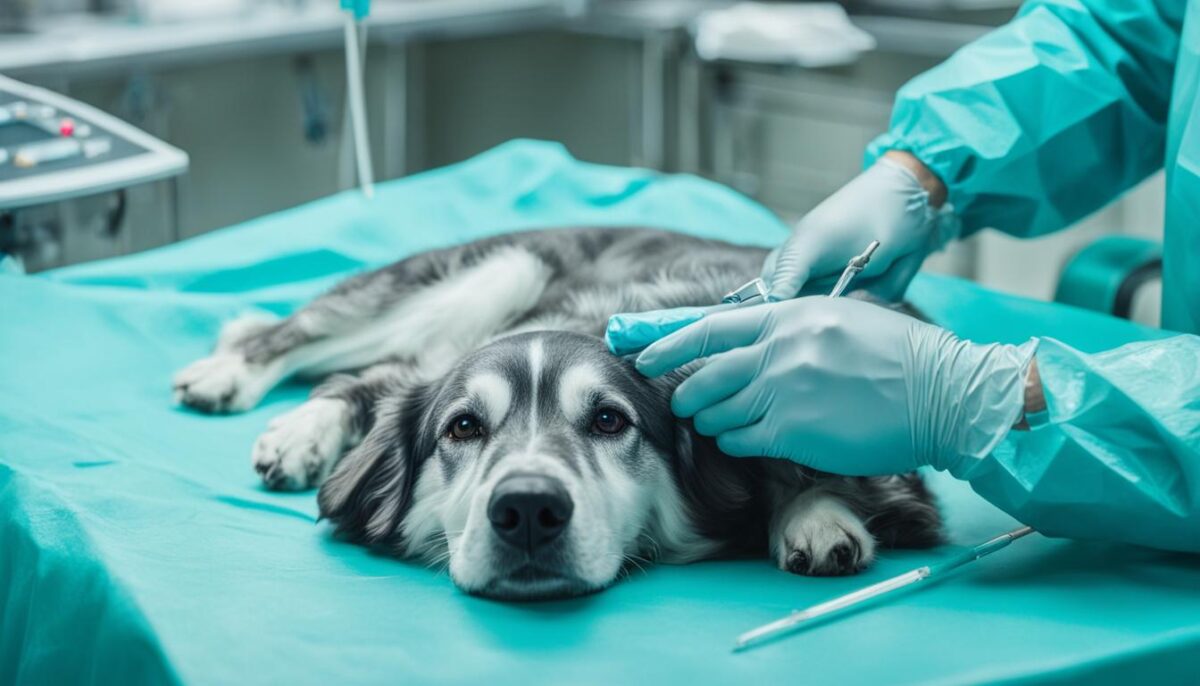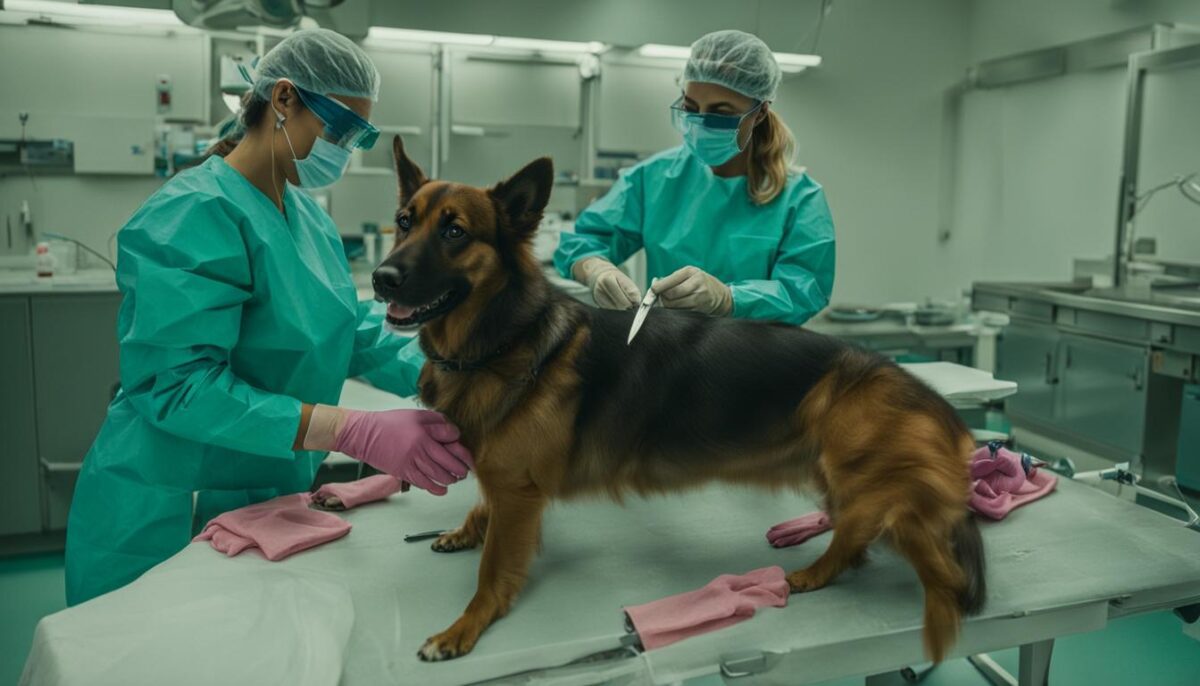If you’ve ever wondered whether you can spay your dog when she’s in heat, the answer is yes, but with some considerations. During the heat or estrus phase of her reproductive cycle, a female dog’s body is getting ready for a chance to have puppies. Some may advise waiting, but sometimes it’s necessary.
Spaying during this time can prevent your pet from getting pregnant and stop future heats. The surgery, which is either an ovariohysterectomy or ovariectomy, is a bit more complex now. Your dog’s insides are more sensitive, which means she might need extra care.
Your vet knows best and can help decide what’s good for your dog. After spaying, your pet will need to rest and avoid playing too roughly to heal properly. It’s important to care for her well during this time.
Key Takeaways
- Yes, dogs in heat can be spayed.
- Spaying helps prevent unwanted puppies.
- The surgery is a bit more tricky during heat.
- Extra care is important after your pet is spayed.
- Your vet can guide you on the best time for spaying.
Understanding the Heat Cycle in Dogs
When your female dog gets to a special time in her life, she starts to go through what’s known as the canine estrus cycle, or more simply, she goes ‘in heat.’ This is when she’s ready for making puppies, and if you notice this happening, it means she could get pregnant if she meets a male dog. Let’s learn about what signs to look out for when your dog is in heat and how often this happens.
What Does ‘In Heat’ Mean for Your Dog?
If you’ve heard someone say a dog is “in heat,” they’re talking about a phase in the dog reproduction process. This part of the breeding cycle is also when your doggy friend can have puppies. It starts when she’s still pretty young, maybe just six months old, or for some big dogs, not until two years old.
Identifying the Signs Your Dog is in Heat
How can you tell if your dog is in heat? Watch out for these clues: a bloody discharge that looks like a tiny bit of blood, her vulva getting bigger, and she might lick herself more than usual. She might act a little different or not want to eat as much, or she might act super hungry. Also, sometimes she may have a small fever. If you see these signs of heat in female dogs, she’s probably in her heat cycle.
The Duration and Frequency of Heat Cycles in Dogs
Each heat cycle usually lasts about 18 days. This can be different for each dog, so it’s not always the same. Even though it lasts a couple of weeks, she might only want to play with male dogs for some of those days, not the whole time. Usually, this cycle happens about two times a year, but again, this can be different depending on the kind of dog you have.
Here’s a table to help you understand better:
| Part of Cycle | What You Might See | What It Means |
|---|---|---|
| Beginning | Bloody discharge, vulva swelling | Your dog is starting her heat cycle |
| Middle | More friendly to male dogs | Best time for making puppies |
| End | Discharge slows, swelling goes down | Heat cycle is almost over |
Remember, taking care of a dog means knowing about these things. It helps to keep your pup healthy and happy, and if you don’t want tiny puppies running around your house, it’s good to know when to be extra careful. If you’re thinking about not having puppies at all, you can talk to your vet about options for your dog.
Can a Dog Get Spayed While in Heat?
If you’ve been asking, “Can my furry friend have spay surgery during heat?” the answer is yes. But, like climbing a high tree, it’s something to be super careful about. When a female dog is in heat, her body is getting ready in case she becomes a mom. This means she has more blood in her tummy parts, and they’re swollen, like a balloon ready for a party. Because of this, pet surgery risks are higher.
Most of the time, your vet might say, “Let’s wait until your dog is not in heat.” That’s because if we do the spay surgery then, it’s safer and not as tricky. But, there are times when waiting might not be the best idea. For example, if there’s a worry she could meet a boy dog and have puppies, or if there are other health reasons, then the vet might say, “Okay, let’s do the surgery now.” In this case, a skilled veterinarian will use their know-how to decide what’s best for your pup.
- Spaying Benefits: Keeps your dog from having unwanted puppies, stops her from having heats, and can help her live a longer, happier life.
- Female Dog Sterilization: Is when a vet does a special surgery to make sure your dog can’t have puppies. It’s a grown-up decision for pet parents to keep their furry kids healthy.
Let’s look at a table that shows us more about when this surgery can happen and what to think about:
| When to Spay | Why Wait | Why Not Wait |
|---|---|---|
| Not in Heat | Less bleeding, less swelling, safer for your dog. | — |
| In Heat | Riskier because of more blood and swelling. | High risk of pregnancy, certain health needs. |
Remember, whether your dog gets spayed during her heat or after, it’s all about what’s safest for her. Talking to your vet is like asking a teacher for help – they know a lot and can guide you to make the best choice for your pet.
The Spaying Procedure: What You Need to Know
When you are getting your dog fixed, which is another way to say dog sterilization, there are a few things to think about. Some vets will do a surgery called an ovariectomy, where they take out the ovaries, or an ovariohysterectomy in dogs, where they take out the ovaries and the uterus. This stops your dog from having puppies and going into heat. Let’s go over what to expect before and after surgery, so you can help your dog stay comfortable and safe.
Pre-Surgical Considerations for Spaying
Before your dog gets the spay procedure, the vet wants to make sure she’s healthy. If your dog is in heat, her insides might be more sensitive, which can make the surgery a little harder. That’s why some vets may say it’s better to wait, but sometimes it has to happen right away.
Understanding Ovariectomy and Ovariohysterectomy
There are two main types of surgeries to stop dogs from having babies. An ovariectomy is when just the ovaries are removed. An ovariohysterectomy is when both the ovaries and the uterus are taken out. Even though these names sound big and scary, they help keep your dog from getting pregnant and having too many puppies that might not have homes.
Post-Surgical Care for Your Spayed Dog
After the surgery, your dog needs your help to get better. She should take it easy, kind of like when you rest after running a lot. For about two weeks, try to keep your dog calm and not jumping around too much. Make sure she doesn’t lick or scratch her stitches so they can heal. If the doctor gave you any medicine for her, don’t forget to give it to her just as they said.
Remember, canine post-operative care is super important so that your furry friend can bounce back quickly and get back to playing and cuddling with you. If you have any questions, always ask your vet for advice – they’re like the doctors for dogs!
Risks and Complications of Spaying a Dog In Heat
When your furry friend is in heat, and it comes time for her pet operation, it’s important to be aware of the potential surgical complications. A vet’s job can get tricky during in-heat spaying, and it’s good for you to know why.
The Surgical Challenges During a Dog’s Heat
Your vet might find the surgery more difficult because of how your dog’s body changes during this time. The inside parts, like the uterus, get extra blood flow and are very sensitive, making it easier for them to bleed or get hurt during veterinary surgery.
Increased Risks of Bleeding and Surgical Time
With the extra blood and tender tissues, your vet has to be super careful. This often means the pet operation takes more time, and they use lots of little stitches to make sure everything heals well. More time and more stitches usually mean it could cost more, too.
How Your Vet Might Mitigate These Risks
Your vet has special tools and skills to make the surgery safer, even if your dog is in heat. They can use things like special cutters that help stop bleeding to take care of those dog health risks.
| Regular Spaying | Spaying While In-Heat |
|---|---|
| Less blood flow to manage | More blood flow |
| Normal tissue handling | Extra gentle handling needed |
| Standard surgery time | Longer surgical time |
| Regular cost | Higher cost due to extra care |
Remember to talk with your vet about these things. They’re there to help keep your dog safe and happy through her spay surgery, even when it’s a bit more complicated.
The Role of Veterinarian Expertise in Spay Surgery
When it comes to the well-being of our furry friends, especially during dog sterilization surgery, the abilities of a trained animal health care professional cannot be understated. Did you know, the success of a spay surgery often depends on the veterinarian skills and surgical expertise of the vet performing the procedure? This is especially true if your dog is in heat because things can get a bit more complicated.
In times like these, veterinarians use their smarts and special tools to make sure everything goes well. Imagine a vet as a superhero for pets, using their powers to keep our little buddies safe and healthy. Their experience really shows when dealing with the tricky task of surgery on a dog that is in heat.
Check out this table that shows just how important a veterinarian’s experience can be when they are taking care of your dog during surgery:
| Experience Level | Benefits | Considerations |
|---|---|---|
| Highly Experienced | Can safely handle surgery complications. | May cost more but worth the peace of mind. |
| Moderately Experienced | Knows surgery steps well. | May need more time to perform surgery safely. |
| New Veterinarian | Eager to prove skills. | Usually assisted by more experienced professionals. |
Isn’t it awesome to know that our vets are so skilled and ready to take on the challenge of helping your pup, even when it’s a little more difficult? They truly are heroes in white coats! Always remember, when your doggy needs medical care, those vet skills are super important.
Next time you visit your local vet clinic, you can be confident that your four-legged friend is in good hands with such a dedicated and knowledgeable animal health care professional. And let’s give a round of ‘appaws’ to those vets with the magical touch that heal our pets!
Conclusion
Making a spaying decision for your furry friend is a big deal, especially if she’s in her heat cycle. As a pet owner, you have a lot to think about. You’ll want to weigh the surgery’s risks with the chance she could have puppies if she’s not spayed. Every dog and her health are different, so it’s not a one-answer-fits-all kind of choice.
When to Consider Spaying During Heat
If your vet feels that everything looks good and is confident in doing the surgery during your dog’s heat, then going ahead might be the best path. Sometimes waiting isn’t the best option, especially if keeping your dog away from male dogs is tough. But remember, your vet knows what’s up. They’ve got the skills to make sure your dog stays healthy and happy.
Alternative Options and Final Thoughts
If it seems too risky to do the surgery while your dog is in heat, don’t worry, there are other choices. You can wait until she’s finished her cycle, keep her apart from boy dogs, or maybe check her into a super nice kennel stay. Vets usually say it’s best to spay your dog before she ever goes into heat. Just keep chatting with your vet about their advice and your dog’s health needs to figure out what’s best for her care.
FAQ
Can a dog be spayed while in heat?
Yes, a dog can be spayed while in heat, but due to increased risks of complications, many vets prefer to perform the surgery when she is not in heat. It is essential to consult with a veterinarian regarding the best timing for spaying your dog.
What does “in heat” mean for my dog?
When your dog is “in heat,” it means she is in the estrus stage of her reproductive cycle and is ready to mate. This period is marked by hormonal changes and physical signs indicating her fertility.
How do I know if my dog is in heat?
You can identify if your dog is in heat by several signs such as a bloody discharge, swelling of the vulva, increased licking of the genital area, behavior changes, altered appetite, and occasional mild fever.
How long does the heat cycle last, and how often does it occur?
The average heat cycle for a dog lasts about 18 days but can vary widely between breeds and individual dogs. Typically, an unspayed dog will go into heat about twice a year.
What are the risks of spaying a dog during her heat cycle?
Spaying a dog during her heat cycle poses higher risks due to the engorged blood vessels and swollen tissues, which can lead to increased bleeding and a longer, more complex surgery.
What are ovariectomy and ovariohysterectomy?
Ovariectomy and ovariohysterectomy are surgical procedures for spaying a dog. An ovariectomy involves removing only the ovaries, while an ovariohysterectomy removes both the ovaries and the uterus, preventing pregnancy and ending the heat cycles.
What does post-surgical care involve for a dog that’s been spayed?
Post-surgical care for a spayed dog involves ensuring she gets adequate rest, avoiding licking of the surgical site often through the use of an Elizabethan cone, administering any prescribed medications, and restricting her movement to prevent complications.
How can a vet minimize the risks when spaying a dog in heat?
Vets can minimize the risks of spaying a dog in heat by using advanced surgical techniques and tools, and possibly scheduling the surgery when the signs of heat are minimal to reduce complications and ensure a safer procedure.
Why is a veterinarian’s expertise important for spay surgery?
A veterinarian’s expertise is vital for spay surgery, especially for dogs in heat, because the surgery is more complicated under these conditions. Experience, skill, and the use of appropriate surgical techniques contribute to safe outcomes and the management of potential risks.
What should I consider before deciding to spay my dog during her heat cycle?
Before deciding to spay your dog while she is in heat, consider the increased risks of the surgery at this time, consult with your veterinarian, and explore other options such as isolating her to prevent mating or delaying the surgery.


